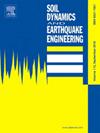CFRP复合材料改善中庭式地铁车站抗震性能
IF 4.2
2区 工程技术
Q1 ENGINEERING, GEOLOGICAL
引用次数: 0
摘要
本文提出了一种碳纤维增强聚合物(CFRP)改造方案,以提高中庭式地铁车站(AMS)的抗震性能。过去的实验研究已经证实,在强震期间,AMS最弱的部分位于上层梁端。然而,到目前为止,还没有一个候选的参考方法来改造和加强辅助医疗系统。本研究通过在上层梁的两端应用CFRP加固来解决这一差距。主要目的是评估拟议的加装计划的成效。首先,建立了三维有限元模型来模拟土壤与ams的动态相互作用。通过与缩小模型试验的实测数据进行比较,评估了数值方法的有效性。其次,利用验证的方法建立了CFRP加固AMS的数值模型。最后,对加固前后的AMS进行了动力时程分析,比较了加固前后的动力响应,包括层间位移、动应变和拉伸损伤,以及周围地面的侧向位移。结果表明,CFRP加固显著降低了上部梁端的主应变和拉伸损伤因子,而梁跨中截面的主应变和拉伸损伤因子略有增加;此外,它不会改变构造的侧向变形。综上所述,CFRP加固可以在不改变AMS侧移刚度的情况下有效提高AMS的抗震性能。本文章由计算机程序翻译,如有差异,请以英文原文为准。
Improving seismic performance of an atrium-style metro station using CFRP composites
This paper proposes a carbon fiber reinforced polymer (CFRP) retrofitting scheme for improving the seismic performance of atrium-style metro stations (AMS). Past experimental studies have confirmed that the weakest section of the AMS during strong earthquakes is located at the upper-story beam ends. However, there is thus far no candidate for a reference approach to retrofitting and strengthening the AMS. This study addresses this gap by applying CFRP retrofitting to both ends of the upper-story beam. The main objective is to assess the effectiveness of the proposed retrofitting scheme. First, a three-dimensional finite element model is developed to simulate dynamic soil–AMS interaction. The validity of the numerical method is assessed via a comparison with measured data from reduced-scale model tests. Second, a numerical model of the AMS retrofitted with CFRP is built using validated methods. Finally, dynamic time-history analyses of the AMS with and without CFRP retrofitting are conducted, and their dynamic responses, including inter-story drift, dynamic strain, and tensile damage, in conjunction with the lateral displacement of the surrounding ground, are compared. Comparison of the results for the non-retrofitted and retrofitted structures shows that CFRP retrofitting significantly reduces both the principal strains and tensile damage factors at the upper-story beam ends while slightly increasing those values at the mid-span section of the beam; additionally, it does not change the structural lateral deformation. Therefore, it can be concluded that CFRP retrofitting could effectively improve the seismic performance of the AMS without changing its lateral stiffness.
求助全文
通过发布文献求助,成功后即可免费获取论文全文。
去求助
来源期刊

Soil Dynamics and Earthquake Engineering
工程技术-地球科学综合
CiteScore
7.50
自引率
15.00%
发文量
446
审稿时长
8 months
期刊介绍:
The journal aims to encourage and enhance the role of mechanics and other disciplines as they relate to earthquake engineering by providing opportunities for the publication of the work of applied mathematicians, engineers and other applied scientists involved in solving problems closely related to the field of earthquake engineering and geotechnical earthquake engineering.
Emphasis is placed on new concepts and techniques, but case histories will also be published if they enhance the presentation and understanding of new technical concepts.
 求助内容:
求助内容: 应助结果提醒方式:
应助结果提醒方式:


